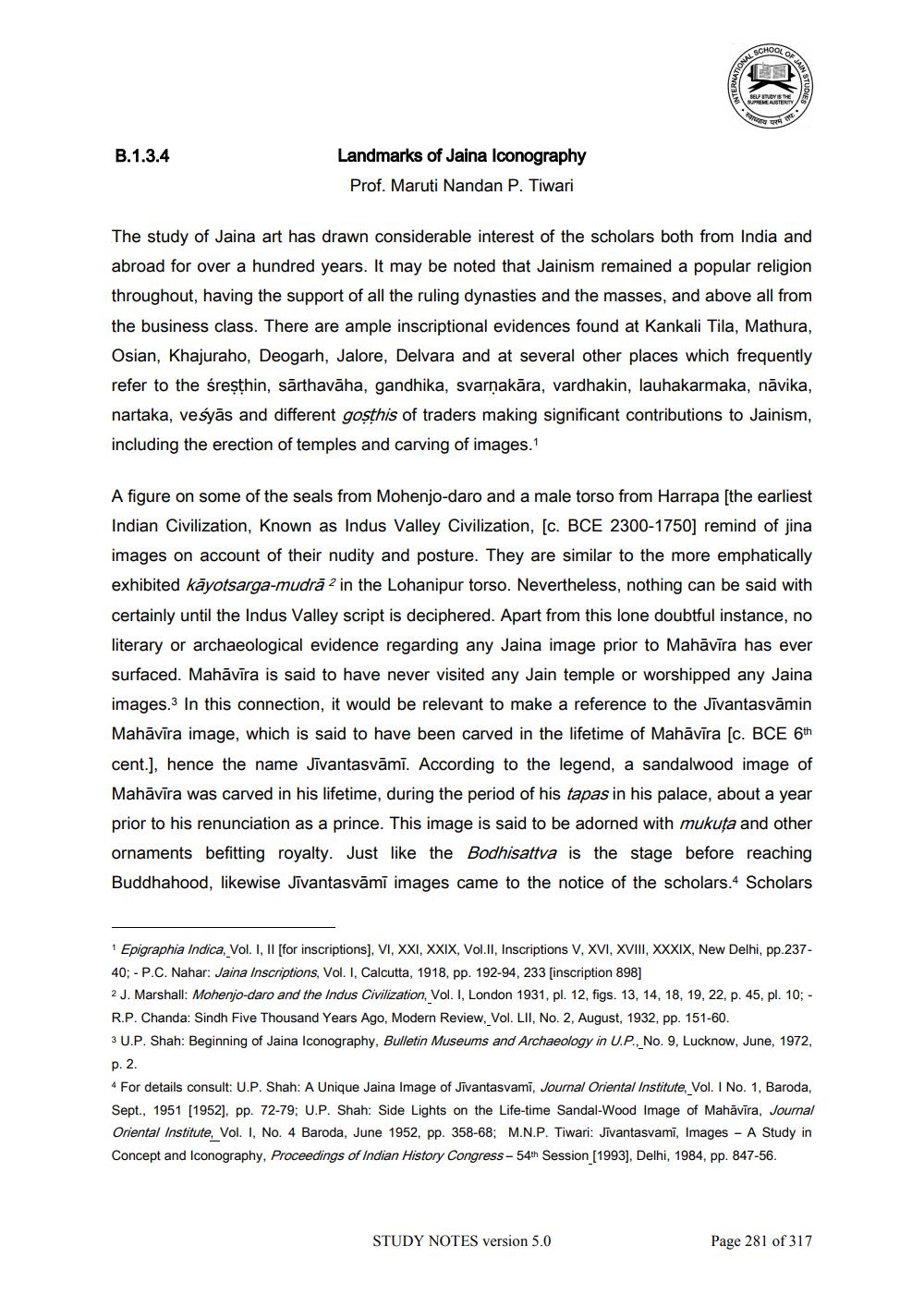________________
B.1.3.4
Landmarks of Jaina Iconography Prof. Maruti Nandan P. Tiwari
SCHOOL
OF
SELF STUDY IS THE
SUPREME AUSTERITY,
STUDY NOTES version 5.0
स्वाध्याय परमं तप
•
The study of Jaina art has drawn considerable interest of the scholars both from India and abroad for over a hundred years. It may be noted that Jainism remained a popular religion throughout, having the support of all the ruling dynasties and the masses, and above all from the business class. There are ample inscriptional evidences found at Kankali Tila, Mathura, Osian, Khajuraho, Deogarh, Jalore, Delvara and at several other places which frequently refer to the śresthin, sārthavaha, gandhika, svarṇakāra, vardhakin, lauhakarmaka, nāvika, nartaka, vesyās and different gosthis of traders making significant contributions to Jainism, including the erection of temples and carving of images.
A figure on some of the seals from Mohenjo-daro and a male torso from Harrapa [the earliest Indian Civilization, Known as Indus Valley Civilization, [c. BCE 2300-1750] remind of jina images on account of their nudity and posture. They are similar to the more emphatically exhibited kayotsarga-mudra 2 in the Lohanipur torso. Nevertheless, nothing can be said with certainly until the Indus Valley script is deciphered. Apart from this lone doubtful instance, no literary or archaeological evidence regarding any Jaina image prior to Mahāvīra has ever surfaced. Mahāvīra is said to have never visited any Jain temple or worshipped any Jaina images. In this connection, it would be relevant to make a reference to the Jivantasvāmin Mahāvīra image, which is said to have been carved in the lifetime of Mahāvīra [c. BCE 6th cent.], hence the name Jīvantasvāmī. According to the legend, a sandalwood image of Mahāvīra was carved in his lifetime, during the period of his tapas in his palace, about a year prior to his renunciation as a prince. This image is said to be adorned with mukuța and other ornaments befitting royalty. Just like the Bodhisattva is the stage before reaching Buddhahood, likewise Jīvantasvāmī images came to the notice of the scholars.4 Scholars
1 Epigraphia Indica, Vol. I, II [for inscriptions], VI, XXI, XXIX, Vol.II, Inscriptions V, XVI, XVIII, XXXIX, New Delhi, pp.23740; - P.C. Nahar: Jaina Inscriptions, Vol. I, Calcutta, 1918, pp. 192-94, 233 [inscription 898]
2 J. Marshall: Mohenjo-daro and the Indus Civilization, Vol. I, London 1931, pl. 12, figs. 13, 14, 18, 19, 22, p. 45, pl. 10; - R.P. Chanda: Sindh Five Thousand Years Ago, Modern Review, Vol. LII, No. 2, August, 1932, pp. 151-60.
3 U.P. Shah: Beginning of Jaina Iconography, Bulletin Museums and Archaeology in U.P., No. 9, Lucknow, June, 1972, p. 2.
4 For details consult: U.P. Shah: A Unique Jaina Image of Jivantasvami, Journal Oriental Institute, Vol. I No. 1, Baroda, Sept., 1951 [1952], pp. 72-79; U.P. Shah: Side Lights on the Life-time Sandal-Wood Image of Mahāvīra, Journal Oriental Institute, Vol. I, No. 4 Baroda, June 1952, pp. 358-68; M.N.P. Tiwari: Jīvantasvami, Images - A Study in Concept and Iconography, Proceedings of Indian History Congress - 54th Session [1993], Delhi, 1984, pp. 847-56.
Page 281 of 317




